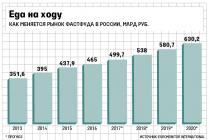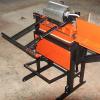It is logical to assume that the most objective data, according to the results of the audit, can only be provided by independent logistics expert. Who, as you know, receives a salary for identifying and specifically showing errors and problems that led to inefficient processes, and not hiding them and keeping silent about them, unlike full-time company specialists, motivated not to take out once again, "dirty rubbish in public."
I often (more than 15 audits) had to be in the role independent expert and in the process of conducting various kinds of audits logistics systems, I, first of all, paid attention to the warehouse ( warehouse logistics) of my customer. Why exactly stock, you ask?
Because a warehouse is a very important indicator by which, practically without error, one can judge some important factors affecting the efficiency of the entire business, just as, for example, a person’s pulse can be used to judge the state of his health in general.
Obviously, when a person comes to the doctor, before starting treatment, the doctor first checks his pulse, pressure, temperature. And according to the state of these and some other easily measurable indicators, he judges how healthy the whole human body is, and whether it is necessary to continue to investigate it further in order to put correct diagnosis.
Also stock. If you want to know how effective (healthy) your business is, the easiest and most logical way to start is to do warehouse audit, and then, based on the results of the audit of the warehouse, decide whether it is worth continuing to examine, or you can immediately begin to solve the identified problems (treatment).
You ask: why is the warehouse acting as this indicator, why, for example, neither purchase or delivery, or sales with finance, because they are also very important links in the logistics system?
The thing is that it is in the warehouse that usually concentrate (merge) all the problems caused by the inefficient work of almost all key divisions companies.
For example, respected purchasing department, ordered and coordinated the delivery of goods to the warehouse in a quantity significantly exceeding its capacity, even taking into account some reserves.
As a result, the goods had to be placed in the aisles between shelving, blocking access to the goods that were on the shelves and subject to picking, and thereby significantly reduce the speed of almost all warehouse operations, and, accordingly, the speed and quality of the set of orders.
It would seem that the mistake was made in the office by a purchasing specialist, who may stock I have never been at all, and as a result, the problem surfaced precisely in the warehouse.
Or, for example, sales department A that ordered a certain quantity of an item to sell to the purchasing department.
The purchasing department ensured the supply in the right amount and at the right time, but the sales department could not sell this product and he "hung" in stock and turned into " illiquid", or worse, in "delay".
And thus took the place highly liquid goods in the warehouse, thus slowing down some very important warehouse processes.
It would seem that the reason sales planning error, and the warehouse, as always, turned out to be “extreme”.
What exactly can be learned from a warehouse audit?
First and the most important- this is how it works in a company inventory management system.
Many executives who are responsible for the effectiveness of the company's inventory management, sitting in the office and looking at their computer monitors, often find it shameful "go down" to the warehouse to see what is really going on there.
And as a result, in their computers for some positions they have one number, but in fact in the warehouse they are completely different. And all because inventory, since it must be carried out, it turns out that it is expensive to carry out, and “reluctance to dirty your hands”.
And here such goods lie in such warehouses, somewhere in the far corner, and on it lies a thick layer of dust. And no one, for the time being, needs this product, and it gets in the way in the warehouse, and there is no sense from it. And if no one, to whom for it "They won't give you a hat", does not remind of such a product, then it will lie until it is written off at the expense of the personal funds of the business owner.
More besides stock status, as a result warehouse audit, you can learn the following useful things, for example:
a) how efficiently money is spent on warehouse maintenance, reconstruction or construction
b) how efficiently warehouse space is used, shelving And lifting equipment
c) How efficient is it? FOT,
d) how productive the staff is,
d) How effective is it? motivation.
e) what is warehouse production culture how it affects the quality of operations performed
g) other important "usefulness"
Another conversation is that not everyone and not always wants to know the truth about their warehouse, but this is another topic not related to warehouse technologies, although no less important in this context.
To illustrate how useful it can be to simply visit a particular warehouse, a particular distribution company, a audits of logistics systems, I will give the following example.
Imagine a warehouse distribution company about 3000 sq. m. with a height of 10 meters to the lower edge of the beam, with rack storage of 4 tiers, floor at +1.2000, self-leveling, with docks, with shipping / receiving areas, a ready-made order area, a storage area and a reject area .. everything is as it should be.
Warehouse, by the way, real. The owner ordered its design and construction according to a template project taken from a beautiful picture on the Internet.
I did an audit of this warehouse in 2011.
Having entered the territory of the warehouse, at 9:00 I saw on the site in front of the docks a cluster of cars for loading, with a carrying capacity of 1.5 to 10 tons, and on the territory there were several heavy trucks(parishes).
Cars for loading were loaded using a forklift, which removed pallets with goods from open docks, put them in front of the cars, and then the loaders and storekeepers manually loaded and placed the goods in the vans.
Why is it not clear for these operations a warehouse with docks?
Since the docks were busy, the trucks that came to unload the receipts stood and waited for the end of the loading of the flow.
When I entered the warehouse, I saw a shipping area occupied by pallets of goods destined for shipping, used as a ready-to-order area. All other processes during the shipment of the expense were not performed due to the lack of personnel and space in the warehouse to perform the corresponding operations.
While in the storage area, I examined base cells and saw that the goods in the base cells were not laid out in such a way that it was convenient to complete them, but scattered(as if it was completed for the last time).
IN picking area there is a product that has not been taken for a long time (it can be seen that it lies for a long time on an even layer of dust on the boxes) and goods in randomly torn boxes (piece) and scattered, including in the aisles.
stacking goods "engaged" reach truck And loader, which can move the goods no higher than 3 tiers, due to the fact that the aisles were cluttered, the equipment was idle (we saved some time on the cargo handling equipment)
The last tiers of shelving were ~90% empty. The third tiers were filled by 50 percent, the second tiers were overcrowded, there was practically no stock of empty cells in them.
From communication with Stacker, after he removed a few pallets for me, I came to the conclusion that the rotation of the goods is unsatisfactory.
By the amount of dust on pallets with goods from the 4th and 3rd tiers, it was clear that this product more than a month has stood idle, and some positions have stood for much longer (some positions have stood idle since the launch of the warehouse)
The product is either not labeled at all, or marked incorrect (delivery date, batch number, product code are not indicated).
After talking with the Warehouse Manager, I found out that inventory in stock are carried out without "empty", when recounting, the goods are not removed from the upper tiers (what is written in large marker on the boxes is recorded).
After observing, a little later, the operation acceptance of receipts, I saw what I expected to see: most of the goods that came to the parish were not arranged as they should be, according to the “fi-fo” principle(or for some other ..), he was simply set aside (into the aisles), because there was a shortage of all the goods that arrived and this product had to be shipped to the next shipment.
Thus, with the naked eye it was possible to see that in this warehouse it is real turns around only about 1/3 of the total volume of goods, and the rest of the product simply takes up all the remaining space, practically without movement.
No ABC warehouse analysis could not have shown this problem more clearly than how it was seen at the present time in the warehouse.
Defective goods was located along with other things, it was collected and written off once a week.
Warehouse personnel changed constantly, staff motivation there was a “curve”, there was no team as such ... people worked from inventory to inventory and almost everyone quit every 3 months.
With all this, the head of the business hired highly paid inventory management specialists, which never went down to the warehouse at all, but at the same time they gave the Customer a lot of different smart tables and calculations regarding the state of stocks in his warehouse, and, oddly enough, he believed them.
In addition to this, the Business Manager had to make decisions within the framework of strict distribution agreements, where strict conditions were provided for sampling inflated volumes of goods for pleasant bonus percentages.
The condition for receiving these bonuses was that at a certain time a consignment of goods arrived at the warehouse without any agreed plan, exceeding several times the usual income rates.
As a result, goods were displayed in the aisles, and all warehouse processes slowed down significantly, or stopped altogether.
Ultimately, the Company carried some indirect costs, which were harder and more unpleasant to calculate than the direct benefits from bonuses associated with an additional bonus to the Head of Business and some of his subordinates, but in magnitude these losses, even on the surface, were significantly higher than the income from bonuses.
After the warehouse audit, purchases and delivery, The head of the business of this company received a complete breakdown of the existing problems according to priorities, and he gradually began to purposefully eliminate them.
Thus, a warehouse audit must of course be done!
Don't let it get to the point where, like in the example above, you have to freeze 2/3 of inventory in non-liquid, following the lead of Counterparties.
It is clear that there are fewer staff with high salaries in the warehouse who are able to lobby the interests of the warehouse in front of the company's management, but still no need to make a "garbage pit" out of the warehouse where to attribute the "jambs" of all other units. It's all too early, in the long run, will only aggravate the overall situation.
But, even if everything is not as bad in your warehouse as described in my example, all the same, you should not stop there.
br
Improve the efficiency of your business, across the entire supply chain! And do not consider it shameful to once again look at the warehouse and communicate with the warehouse staff!
brWarehouse audit will help you evaluate the efficiency of the warehouse system, its components and many logistics processes. Find possible ways to optimize work processes and reduce storage space.
The GICOM company will audit your warehouse and give a list of recommendations for improving the work.
Required data for audit:
- Warehouse logistics questionnaire - as is and forecast for 3-5 years (or % growth)
- Warehouse layout with dimensions
- The list of restrictions - the maximum number of receipts to the warehouse, the maximum productivity of each line, the maximum and minimum volume and weight of one SKU, etc.
- Photos of the current warehouse - along the outer perimeter and inside
Warehouse audit technology:
- Analysis of current intra-warehouse logistics
- Analysis of warehouse processes
- Warehouse management system audit
- Determination of the structure of cargo flows
- Audit of storage efficiency of products on racks
- Analysis of the topology of the location of equipment in the warehouse and production
- Identification of "bottlenecks" - "points of growth", the optimization of which will increase the amount of goods received and shipped, storage capacity, depending on the tasks of your warehouse and production.
The history of the development of such a category as audit is viewed differently by many authors. The corresponding definition in translation from Latin is interpreted as "hearing" and is used in practice to determine the verification. Thus, it is customary to understand an audit as a check carried out by an independent expert, aimed at a certain activity or phenomenon. That is why a distinction is made between technical, operational, environmental, and logistical audit, which is discussed in this article. What is meant by the presented category? How is she different from others? What are the types of logistics audit? These and other equally important questions can be answered in the process of reading our article.
The concept and organization of a logistics audit
Today, along with the concepts of financial, accounting, technical and other types of audit, an important position is occupied by a logistics audit. First of all, its action is aimed at reducing the costs of a logistical nature and increasing the efficiency of the economic activity of the enterprise as a whole.
A logistics audit should be understood as a comprehensive check of the efficiency of the logistics subsystems. The role of a logistics audit in choosing a logistics strategy is to identify "problem areas". So, in the course of the procedure, a tree of relationships between them is formed, which are of a cause-and-effect nature. In addition, a large-scale economic calculation is carried out in relation to sales, space utilization and inventory management. The organization of a logistics audit and the stages of conducting are directly related to the following types of audits:
- Audit of purchases, that is, logistics.
- Audit of planning according to the scheme "sales - production - purchases".
- Audit of logistics costs for warehousing, packaging, storage and movement of marketable products.
- Audit of the distribution of marketable products in accordance with the supply chain.

Logistic audit results
In addition to the organizational issue, the theoretical basis of the logistics audit system also includes the result of the procedure in the form of a report containing the following information:
- Assessment of the actual state in relation to the logistics system of the enterprise.
- A list of technical, informational, organizational and technological recommendations for improving all logistics subsystems.
- Assessing the need for certain changes.
- Preliminary (potential) return on investment.
The results that are announced after such a procedure as an audit of logistics systems usually speak of the relevance of certain projects related to the following points:
- Development of a strategy in terms of the logistics component of the structure.
- Reengineering (design) of a system or a logistics subsystem. A striking example of the latter is the design of a warehouse complex.
- Formation of a system related to the regulation of logistics business processes.

Logistic audit and its main principle
The key principle of the logistics audit is the evolving movement from the general to the particular. In other words, the procedure begins with a review of the goals of the global focus structure and ends with the causes of missed opportunities, low productivity, and low efficiency. After working out general issues, the logistics audit of an enterprise involves a detailed study of the logistics functional areas in the company.
So, in accordance with the above principle, the current strategies of the enterprise are studied, which can fully influence the organization in terms of the movement of flows of material nature. In any case, this requires an analysis of the corporate mission, as well as the production, marketing and purchasing strategy of the company. The audit of logistics systems, as its final step, includes the formation of a database. So, it can be used to evaluate the performance of these systems in the enterprise.
To implement the procedure discussed in the article, a team is created, including representatives of the logistics service and other functional divisions of the company (accounting and finance, sales and marketing, procurement and production, information service, and so on). It is important to add that, for example, a logistics audit of an enterprise's transport system is carried out in the presence of external experts. In addition, students of specialized higher educational institutions are often involved in the implementation of the procedure. This move is undoubtedly expedient, because novice specialists, one way or another, need a practical basis to achieve their professional goals.

Stages of compiling branches of logistics audit
Modern scientists distinguish between several stages of a logistics audit, including preliminary, main and, accordingly, final. To begin with, it would be advisable to consider the preliminary stage of the logistics audit.
So, during the first two or three days, specialists study the functional areas of production, supply, sale and marketing of commercial products. Then, during the week, logistics experts process the results of the research, as well as prepare a list of logistics functions, which, one way or another, are subject to thorough verification. Logistic audit in its final line at this stage contains the formulation of questions for questionnaires and interviews, as well as the compilation of a list of indicators in accordance with which the logistics functions will be assessed.

The main stage of the logistics audit
To begin with, it should be noted that the main stage of such a large-scale procedure is classified into internal and external audit. This chapter discusses the audit of logistics costs on the example of an industrial enterprise and its main stage. The starting point of an internal audit is an interview with the head of the enterprise. After that, the logistics audit is carried out in accordance with the following areas:
- The first direction involves a survey of employees of the functional divisions of the company on issues that, one way or another, are related to logistics (sales, warehouses, transport).
- The second direction involves working with a sample of enterprise documentation.
- The third direction speaks of the collection of information in accordance with supply contracts for the statistical analysis of sales and purchases of marketable products.
In the process of internal logistics audit, a system of indicators is used, which are classified into the following groups:
- The first group contains indicators of servicing external and internal consumers, as well as an assessment of the quality characteristics of the service, which includes the ability to fundamentally change the features of orders in accordance with customer requests, the time of order execution, as well as stability in relation to this time.
- The second group includes indicators that are directly related to the cost of funds for the implementation of logistics operations and procedures. In the process of cost analysis, an assessment of the cost-benefit ratio is made. This refers to the benefits that customers receive from the adoption and further implementation of certain decisions in the company.
- The third group includes several indicators of the use of its own fleet of vehicles (rolling stock) or storage facilities, including the coefficient of application of the carrying capacity of the vehicle, the coefficient of application of the warehouse volume, and so on.

External audit
As it turned out, the main stage of the procedure considered in the article contains such types of logistical audit as internal and external. In this chapter, it will be useful to familiarize yourself with the latter. It is important to note that it makes sense to start an external audit only when the internal audit procedure is guaranteed to be passed. So, at this stage, the expectations and requirements of the clientele are studied in order to determine the optimal performance of the enterprise; consideration of the techniques used by competitors; assessment of the level of service to consumers of the material flow, and so on.
It should be noted that an external logistics audit is carried out in the form of mailing specially prepared questionnaires or selective interviews directly with representatives of the companies served, as well as buyers from different geographical locations or with different volumes of purchases. It is important to add that standard questionnaires are necessarily adapted to each structure being checked. In addition, as a rule, not only the heads of the company or its individual divisions are interviewed, but also specific employees in accordance with their field of activity.
Thus, based on the results of an external audit, it is possible to form specific recommendations for the structure and indicate the changes that need to be made in the current logistics system at the time of the audit.
The final stage
After the main stage of the logistics audit has been completed, it is necessary to prepare the following analytical reports:
- The first report, developed in accordance with the analysis of the range of stocks, contains information about the range of raw materials and commercial products, stocks by groups, categories or positions, and estimates of the turnover of positions by stock.
- The second report contains an analysis of the cash flow in the company, as well as outside it. For example, a detailed description of the movement of cash flow through the warehouse in general and the volume of cash flows in accordance with each logistics operation separately. It is important to note that on the segments of the line located between the storage areas, it is also important to indicate the amount of cash flow. The results obtained are used to determine the number of loaders and vehicles for intra-warehouse purposes.
- The third report is devoted to equipping the enterprise with resources. Thus, the relevant information includes the classification and characteristics of loading and unloading equipment. The main purpose of the description is nothing more than an assessment of the material and technical base relevant to the enterprise.
Summarizing information
As it turned out, a logistics audit is carried out in order to identify shortcomings in the logistics system of the structure. After identifying “bottlenecks (areas with increased risk), one way or another, logistics experts develop recommendations to correct the identified problems. Of course, these recommendations are subsequently used to improve the level of service for existing customers, find new ones, as well as to improve cash flow management.

An example of a logistics audit
In this chapter, it would be advisable to consider the logistics audit procedure using a specific example. A warehouse audit is nothing more than a search for methods to improve warehouse performance within the scope of an express study of warehouse processes and resources. This event can be carried out both on a one-time basis and on an ongoing basis. As noted above, a logistics audit is mainly aimed at identifying shortcomings in the organization of the warehouse, as well as in its work. In addition, in this case, it is appropriate to create certain proposals to eliminate the deficiencies found. A particular task of the procedure considered in the article is often the justification that the warehouse needs to be automated.
Often, a logistics audit is considered a mandatory step preceding the implementation of a WMS system. Thus, the results of research and the relevant recommendations of logistics experts make it possible to find the most optimal options in terms of storing commercial products, as well as optimize the implementation of warehouse operations, the number of employees, loading, and so on. In other words, a logistics audit, one way or another, contributes to the realization of what needs to be done in the warehouse to bring it into absolute order before automation.
Logistic audit in practice
Warehouse logistics audit includes the following operations:
- Infrastructure analysis.
- Analysis of the technical process.
- Analysis of current documents.
- Analysis of computer and information systems.
- Development of proposals and recommendations to improve the situation.
- Calculation in terms of a feasibility study for the implementation of a WMS system.
In the process of performing a logistics audit of a warehouse, the following tools are used:
- Interviewing company employees.
- Supervision of the working process in the warehouse.
- Analysis of current documentation, including work instructions, flow charts, layouts, and so on.
The results of the logistics audit in the warehouse are the following points:
- List of current problems for the enterprise.
- Recommendations for solving existing problems.
- Rationale for the need to introduce an automated system.
Warehouse logistics audit.
A logistics project is usually carried out after a logistics audit that answers the question:
What to do?.
The logistics project answers the question:
How to do?
Warehouse logistics auditis the most demanded job in the field of logistics consulting , which, as a rule, consists of the following sections of the TOR:
Receipt and analysis of initial data on the layout, goods movement of the warehouse. Commodity, information, documentary flows, economic efficiency, IT and technical equipment of the warehouse are analyzed. Data is obtained from various sources: questionnaires, employee surveys, site inspections, downloads from IT databases, etc.
Analysis of the overall performance of the SC, incl. warehouse logistics systems, warehouse layout, product placement schemes, technical equipment of the warehouse, technical and economic indicators of work, product range, commodity circulation and document management systems in the warehouse, conduct an examination of the information system, motivation system and the level of training of warehouse personnel.
Data is obtained from various sources: questionnaires, employee surveys, site inspections, downloads from IT databases, etc.
Preliminary analysis of the effectiveness of existing technologies for the receipt of goods, storage, commissioning, packaging, release, etc. Identify "bottlenecks"
Identification of the main problems in the functioning of the warehouse logistics system, setting goals and management tasks, ranking tasks.
Preliminary determination of the cost of development and implementation of projects for optimizing the management of warehouse systems and reengineering technologies for cargo handling.
Preliminary assessment of the possibility of reducing the share of storage costs in the final cost of products with various options for management decisions.
Forecast of long-term results.
Based on the results of the audit, the logistics expert submits to the Customer the final reporting document on 30-50 pages which includes the following information:
Generalized statistical data on the dynamics of trade turnover, cargo turnover and technical and economic indicators of the overall efficiency of the UK to the performance indicators of the logistics system of the UK and its elements, processed according to questionnaires
Analytical part with audit findings
All proposals and recommendations of the expert on optimization and efficiency improvement presented in the final document are of an applied practical nature , allowing the Customer the opportunity to apply them for:
Evaluation of the effectiveness of the existing SC logistics system
Making managerial decisions to improve the overall efficiency of the SC
The expert can take part in the process of implementing and adapting recommendations on the logistics system of the Customer's warehouse within the framework of an additional agreement.
According to our practice very often, in agreement with the Customer in the TOR, as part of the recommendations of the logistics audit, the expert performs work on the development of the concept of the warehouse and the technology of its operation, describes the business processes "as is", conceptually describes the technology "as it should", develops several planning solutions for the warehouse with an approximate calculation of zones and the number of racks.
But these developments are of an approximate nature and do not have the detail and quality of a logistics project.
The duration of the audit is 3-4 weeks.
Composition and procedure of warehouse logistics audit | logistics expert N. Lobanov (relevant for 2017) | |
| Name of service | For what? What does the customer get as a result of the service. | |
| Definition and coordination with the Customer of the Purpose and Tasks of the audit | Increased efficiency from investments in logistics audit | |
| Creation and approval of the WG - a working project group of key employees. Appointment of RP by the customer. | Risks are reduced when an expert interacts with company employees, the quality and efficiency of work in the audit process are improved | |
| Stage No. 1 Collection of initial information | ||
| .1 | Preparation of data sheets (questionnaires) to collect initial information, in accordance with the objectives of the audit | Standardization and unification of information in the OL allows to reduce the time of collecting the initial information. The quality of the original data is improved. It becomes possible to conduct a comparative analysis of the work of the warehouse with similar warehouses in the industry. |
| .2 | Obtaining through the RP from key employees the initial information that is required for the audit | The coordination and interaction of the work of the WG in the project is improving. The risks of "sabotage" of employees when receiving initial data are reduced |
| .3 | Analysis of the information received in the OL, its verification. Request for additional information if there is any doubt about its correctness. | As a rule, when collecting initial data, there is always a "deficit" of information and its distortion, intentional or unintentional. Several sources of obtaining information, conducting several iterations during its verification, can reduce the risk of errors in the audit and improve the quality of recommendations to the Customer. |
| .4 | Obtaining initial information directly in the warehouse through employee interviews, photographs of the working day, research of warehouse PSUs and on-site operations. | The work of an expert directly at the warehouse allows to reduce the risk of errors in the analysis of information received remotely by OL. This method is used to obtain the missing initial information that is not in the corporate information system and the company's workflow. Allows you to establish contact with warehouse employees and more effectively conduct an audit. |
| Stage No. 2 Analysis of the initial information | ||
| .1 | Analysis of GO-cargo turnover, TO-goods turnover, TK - commodity stock, assortment matrix in the context of: days, weeks, months, years (3 years). Analysis of the turnover of commodity groups, illiquid assets. | Allows you to get a complete picture of the movement of goods in the warehouse and the correct data to evaluate its effectiveness. |
| .2 | Analysis of basic KPIs - key performance indicators of the warehouse. Comparison with industry KPIs of other warehouses. | Numerical calculated KPIs are the basis for correctly assessing the performance of a warehouse in comparison with similar warehouses in the industry. |
| .3 | Analysis of indicators of "capacity of the warehouse", indicators of the efficiency of the use of warehouse volumes. Determining the level of "peak" loads on the warehouse. | Allows you to determine the marginal human and technical resources of the warehouse, which reduces the risk of failures in the warehouse and failure to fulfill its operational tasks. |
| .4 | Analysis of the technology of the warehouse for the main business processes. (Acceptance, storage, assembly, replenishment, selection, shipment, inventory). | The level of technology is the basis for efficient operation. The analysis of the main BPs makes it possible to find PAs in the technological process and then eliminate them. |
| .5 | Analysis of the warehouse system for its effectiveness in terms of labor productivity, customer service level, economic indicators, inter-warehouse movements. | If there are several warehouse premises remote from each other, there are problems with inter-warehouse movements and warehouse storage, which entails additional costs and a decrease in the efficiency of the warehouse system. The analysis allows you to identify the UM in the warehouse system and optimize the work of the warehouse. |
| .6 | Analysis of the layout (topology) of the warehouse for its effectiveness for the selected work technology. | The layout of the warehouse should provide the possibility of implementing the selected work technology. Inadequate warehouse layout technology will "slow down" warehouse operations, reducing their efficiency. |
| .7 | Analysis of PTO-handling equipment for efficiency with the selected technology and layout. | Warehouse mechanization and IT should be adequate to the chosen technology and warehouse layout. "Manual labor" is unproductive. |
| .8 | Document flow analysis (electronic and paper). | Primary accounting documents must be drawn up at the warehouse in accordance with PBU. Electronic document management allows reducing the "human factor", increasing the productivity and quality of the warehouse. Allows you to make inventory accounting "transparent". |
| .9 | Analysis of the "Accounting policy", cost accounting systems, their "distribution base", checking the correctness of the calculation of the cost of warehouse logistics operations. | Cost management allows you to reduce the cost of goods, is the basis in the inventory management system (CMS), which increases the profitability of the entire company. |
| .10 | Warehouse IT equipment analysis. Checking the functionality and strategies of WMS. Verification of the application of ABC and XYZ analysis methods. Checking the level of automation of operations, the interface between WMS and CIS (corporate information system). Study of the principles of building an address storage system and a system for marking goods and equipment. | Allows you to significantly increase the productivity of warehouse operations, reduce their costs, improve the level of service. On the basis of the Pareto Rule 80/20, a whole branch of mathematical analysis, the so-called ABC analysis, is built, which is based on the division of the object of analysis into three groups according to their degree of importance and effectiveness according to a certain criterion. In logistics, the 80/20 methodology and ABC are axioms, as they work very well in practical application. There are many examples. 20% of operations have 80% of labor intensity 20% of customers bring 80% of the company's turnover |
| .11 | Analysis of the TC-technological map of the warehouse, BP Regulations (business processes), Functional instructions. | Business processes can only be managed by a Torda when they are described and formalized. Process management allows you to automate 80% of operations and reduce the influence of the "human factor" in administrative management. |
| .12 | Analysis of the rationing system for warehouse BP and operations. | The rationing system is the basis for planning operations, which allows you to reduce risks and increase the efficiency of the warehouse. Also, the rationing system allows you to calculate the duration of operations, their labor intensity, allows you to calculate the required human and technical resources. |
| .13 | Analysis of the system for planning the work of the warehouse and the interaction of the warehouse with related departments of the company. | Without a planning system, a warehouse cannot be efficient. Warehouse BPs are located in the middle of the supply chain, so the efficiency of warehouse BPs is highly dependent on the incoming and outgoing BPs of adjacent departments. The regulation of the interaction of the warehouse with adjacent departments allows you to coordinate and synchronize the BP of the entire company. This achieves a synergistic effect. |
| .14 | Analysis of the warehouse personnel motivation system. | Personnel motivation is the basis for the effectiveness of the implementation of the BP. Good warehouse motivation increases the productivity and quality of work of the warehouse staff by up to 70%. |
| Stage 3 Based on the analysis of the initial information, the definition (UM) of "bottlenecks". | This paper uses the concept of "supply chain", part of which is the theory of "bottlenecks" Goldrat or "weak link in the chain". (Recipe by Dr. Goldratt. About the theory of constraints by Eliyahu Goldratt (Theory of constraints; TOC). | |
| .1 | Definition of UM in the warehouse system and warehouse layout | It allows you to optimize the warehouse system, eliminate problem areas in the layout of the warehouse, which increases the utilization rate of the warehouse volume, increases the capacity of the warehouse, and increases labor productivity. |
| .2 | Definition of UM in warehouse operation technology | Technology is know-how. The improvement of technology leads to an increase in the efficiency of the warehouse as a whole, as well as the entire company. |
| .3 | Definition of UM in the technical equipment of the warehouse and the use of IT. | Allows you to reduce the level of "manual" unproductive operations |
| .4 | Definition of UM in the accounting policy of the warehouse | It allows efficient use of warehouse resources, making the calculation of the cost of goods planned and estimated, which entails a decrease in warehouse stocks, a decrease in the share of logistics warehouse costs in the company's turnover, increasing its profitability. |
| .5 | Definition of UM in the warehouse automation system, assessment of the level of formalization of BP (business processes) | Allows you to implement a more efficient process management system. |
| .6 | and etc. | |
| Stage No. 4 Recommendations for the elimination (LM) of "bottlenecks" and optimization of the warehouse. | ||
| .1 | Recommendations directly for each identified UM. | For each UM, the Customer receives an answer to the question: What to do? in order to eliminate it. |
| .2 | Recommendations of a systematic nature for optimizing the work of a warehouse in a company | "Patchwork optimization" of warehouse PSUs is much less effective than optimization with a systematic approach to the supply chain. |
| .3 | Assessment of the potential for reducing the share of storage costs in the final cost of products with various options for management decisions. Forecast of long-term results | An assessment is given on the limits of the possibilities of optimizing this warehouse. |
| .4 | Assessment of the level of investments and payback periods in the systemic modernization of warehouse logistics | An assessment of investments in the optimization of the warehouse is carried out according to the main recommendations and the payback period for making a management decision on further work within the framework of a logistics project. |
| .5 | Recommendations for the reengineering of the entire company and, as a result, the improvement of the logistics system. | |
| Standard set of warehouse logistics audit services | Price from see rub, duration 4-6 weeks | |
| "Travel" expenses of the expert (outside the Moscow region) | from 50 000 rub | |
| Total for the audit: | from under the contract rub | |
| Additional services within the framework of the logistics audit of the warehouse. | ||
| .1 | Research and analysis according to OL No. 8 Cyclograms of the warehouse operation during the day according to the main BP. Cost of services: 70 thousand rubles | Warehouse cycle diagrams allow you to make the optimal work schedule for warehouse personnel by shifts and BP groups, which reduces warehouse costs and improves the quality of the service level. A cyclogram can be made only if there is a WMS, from which you can download data in a certain format! |
| .2 | Carrying out selective timing of the main warehouse operations in order to verify the correctness of the warehouse operations rationing system. Cost of services: 70 thousand rubles | "Correct" standards for warehouse operations can improve the efficiency of the warehouse planning system and the personnel motivation system. "Incorrect" regulations can lead to "sabotage". A selective check of the standards will make it possible to determine the UM in the system of rationing warehouse operations. |
| .3 | Description of the main BP "As is" Cost of services: 100 thousand rubles | If there is no description of formalized BP in the warehouse, then the description of BP "As is" will initiate further work on the formalization of BP, without which automation of BP in IT resources is impossible. |
| .4 | Development of new planning solutions for the warehouse Cost of services: 80 thousand rubles | If gross errors in the topology (planning) are made in the warehouse, then the development of 2-3 optimal layouts is required, which is the initial stage of the logistics project. |
In the current market situation, many owners and managers of companies turn to the company with a request to give recommendations, prompt or help with increasing the efficiency of warehouse logistics. Indeed, since 2004, our consultants have been helping their clients find logistics bottlenecks and develop unique logistics solutions that help create competitive advantages and help establish logistics services.
Therefore, we decided to talk about how it is possible to increase the level of efficiency of warehouse logistics using the example of one of the clients, whose development history is indicative and typical..
A large trading company that has developed over the past 15 years at different rates: first it rented a warehouse with an area of 1000m2, then as sales and balances grew, so did the rent, at the moment it is 3 warehouse complexes for rent of 1500-1000m2 located nearby, as well as 2 storage boxes of 150m2 each rented separately for storing seasonal goods, plus outsourcing up to 500 pallet places depending on the supply of containers.
Before the crisis of consumer demand, the owner of the company had a fairly high margin on goods, saw losses in logistics in the region of 2-4% of turnover, but “turned a blind eye to them”, since the company was practically doubling every 2 years..
The market situation has changed since 2014, and I had to “roll up my sleeves” - “cut the bones”: in 2015, the staff, office, operating expenses were optimized ... Once, having visited his warehouses, the owner realized that he needed to figure it out and close a couple of warehouses, having sold illiquid assets. “As it was said, so it was done” - they quickly sold out illiquid assets, optimized and revised the balances, vacated a couple of warehouses, abandoned safekeeping, reduced part of the warehouse staff, bought additional racks and 2 loaders to speed up shipment ... Logistics costs decreased, and the situation seems to have returned to normal.
However, a year later, the sales department found an interesting niche, tried test sales, and realized that it was urgent to develop the direction, signed a lucrative contract for the supply of 30 containers with goods from Taiwan, everything would be fine, but remembered that the warehouses were "optimized" and there was no place to store arriving containers?
The eternal question arose before the owner - what to do? Again, look for an answer storage, or rent a warehouse nearby for a year, recruit new staff .. At the same time, the existing staff is underloaded, the new assortment is required by 30% of current customers and must be completed in one truck, which means that one more transportation of goods from the new warehouse to the current one (where there is one transportation anyway) will be added, and this is another loss of 1 day, and it’s not a fact that they will bring what they need, they won’t break it on the road or they won’t steal it, they will lose it .. At the same time, after the launch In this direction, competitors will immediately become more active, who will be able to ship goods faster, including in the network, and the profit of the direction will begin to eat up logistics, plus a possible exchange rate difference - to transport 5 containers or 10 at once? And again the cycle - where to place, a vicious circle ..
Common situation?! We have met a lot of companies whose owners understand how to invest: in the development of new areas, the opening of production, the expansion of the fleet, but for some reason, warehouse logistics is remembered last?
As a result, the owner decided to turn to consultants Bestlog - logistics consulting for help in solving this problem. To assess the situation, it is not necessary to go to the client - sometimes the following documents are enough:
- master plan with warehouse landing and racks (in autocad);
- GPZU, topographic survey with networks
- a completed questionnaire on the commodity flows of the warehouse "as is";
- photos of the warehouse around the perimeter inside;
- warehouse structure, warehouse operation regulations, CI, RI, regulation on warehouse motivation
- logistics budget for the current year,
- access to the ERP system for inventory accounting assessment (by receipts, internal movements, inventory, shipment, turnover sheet, directories)














